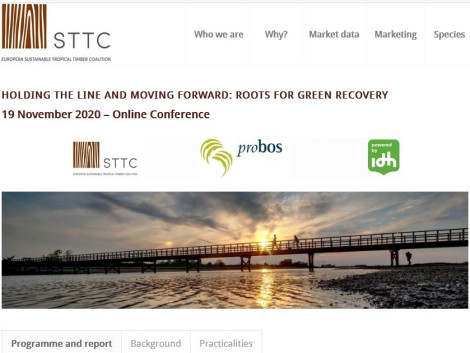

News | 08.12.2020
The 7th annual STTC conference was held on 19 November on the theme "Holding the line and moving forward: roots for green recovery". The STTC team was delighted with this interactive and stimulating online event and thanks the participants for their presence and the ideas shared.

During the event, around 150 participants joined from all around the world and from a diverse stakeholder profile along the tropical timber supply chain. The virtual event has enabled not only to reduce the conference footprint but provided the opportunity to reach a broader and more diverse audience.
The online conference’s focus was the need to halt tropical forest loss and associated adverse climatic impacts and wider environmental degradation and to incentivise implementation of sustainable forest management (SFM) by expanding the market for verified sustainable tropical timber. The complementary core theme was the growing understanding that, to tackle the environmental crisis more broadly, society globally needs to adopt a circular bioeconomic model, a core element of which is greater and more efficient use of sustainably produced natural raw materials. It’s a view recently given greater currency, with post-pandemic economic reconstruction seen as a major opportunity to accelerate this transition. Sustainable tropical timber supply, said speakers, must be presented as integral to achieving this ‘green recovery’ and the bioeconomic switch.
Among the speakers, Jeroen Nagel, Circular Economy Advisor at the Dutch Directorate General for Public Works and Water Management, gave the perspective on these topics of the Netherlands, one of Europe’s foremost advocates for moving to a circular bioeconomy and its leading tropical timber importers. The Dutch experience was that making this economic transformation could not just be a top down process. It demanded public-private partnership and willingness of business and society to make the change. “That requires highlighting the multi-benefit promise of a circular economy,” said Mr Nagel. “Not only can it reduce CO2emissions, it can generate green jobs, cut waste and save business and consumers money. ”While government alone could not drive the transition, added Mr Nagel, public procurement could help ensure sustainable tropical timber was part of the bioeconomic mix. As an example, he presented the ‘Biological Highway’ conceived by his ministry with industry partners, a blueprint for using tropical wood instead of steel and concrete for motorway fixtures, such as barriers, lamp post sand signage.
Dr Lee White, Gabon’s Minister of Water and Forestry, issued a clear warning to the 2020 Sustainable Tropical Timber Coalition Conference. Given it’s vital carbon storage and meteorological regulating role, he said, only by preserving Congo Basin forest can man-made global warming be limited to the critical level of 1.5°C or lower. And the same applied to the tropical forest resource elsewhere. Dr White stressed that tropical wood producers, as well as consumer countries, should set their sights on moving to a circular bioeconomic approach. This was Gabon’s ambition. The country was formally primarily a log exporter, realising just3-4% of the value of its timber and 5% of the potential jobs the timber sector could support. This changed in 2010with government insistence on 100%timbertransformation in Gabon and a ban on log exports. Currently the country is still primarily producing sawn wood, but has plans to move increasingly into further processing. Its objectives are exemplified by a special economic zone near Libreville, home to 100 timber and wood product companies. “This is developing on circular economic lines,” said Dr Lee. “Companies are undertaking first, second and third level transformation, and all hardwood waste is turned into activated charcoal. Gabon’s first MDF plant is also under construction to use waste Okoumé.”
Hugo Schally, Head of Unit Sustainable Production of the European Commission Directorate General Environment, described the EU’s circular economy action plan and its aim, under the auspices of its Green Deal, to ensure deforestation-free supply chains. Both held potential benefits for use of verified sustainable tropical timber, driving demand for biomass-based products and providing assurance on sustainable supply. Ensuring deforestation-free supply chains, in turn, will demand increased industry transparency and provision of more information to trade buyers and consumers about the origin and circumstances of production for commodities.
Numerous testimonials followed one after the other: Maria Smith of consulting engineers Buro Happold said the building industry is key in making a lower environmental impact circular economy feasible. “There is growing awareness of the need to move to a ‘regenerative built environment’ that takes greater account of both natural environment and social need. The aim is buildings that have a positive impact on health and well-being, improve air quality and generate green jobs,” said Ms Smith.
And, John Williams of engineering, environmental and technical services consultancy RSK, stated that it was possible to increase the range of sustainable tropical timber species in construction and civil engineering and to develop their circular economy potential. His research has looked at developing structural applications and growing the market for sustainable timber from Guyana and Ghana, including lesser known timber species(LKTS).
Two major European companies also intervened on the Covid pandemic-19 : Interholco, which manages over 1 million ha of FSC-certified forest in the Republic of the Congo, and importer and international trader Vandecasteele. The pandemic tested the commercial resilience and adaptability of the tropical timber sector worldwide but it has also underlined the wider obligations, social, environmental and economic, involved in running sustainable forest and timber businesses.
Following the observation made by Mark van Benthem, of independent SFM knowledge institute Probos, that the implementation of certification has slowed down over the last five years, Liesbeth Gort, director of FSC Netherlands, presented her initiative for certified ecosystem services, launched two years ago. “Under this forestry companies can demonstrate the positive impact of their SFM on five types of ecosystem service; carbon, soil, biodiversity, water and recreation,” she said. This evidence of impacts, under the FSC trade mark, can subsequently be used by forestry timber businesses, their customers and investors in marketing and to secure monetary and other benefits.
Iwan Kurniawan of The Borneo Initiative recommended greater collaboration and synergy between FSC and the EU FLEGT programme in Indonesia to streamline auditing and improve the economics of certified sustainable forest management.
Mark van Benthem also presented the latest IDH tropical timber data monitoring report, commissioned by IDH, the Sustainable Trade Initiative on behalf of the STTC and produced by Probos and the Global Timber Forum. This was undertaken with correspondents in key European national timber markets and used the exposure* to certification method to assess certified percentages of tropical imports. It found that 33% of Europe’s direct imports of secondary tropical products in 2019 were exposed to certification (compared to 28.5% of primary products in 2019). This, said Mr Benthem equated to 735,000 to 925,000 ha of tropical forest being positively impacted.“ And ramping up to 100% certified secondary product imports would increase that to over 2 million ha and, in combination with 100% certified primary products, to 18 million ha,” he said. Mr van Benthem added that the STTC was continuing to strengthen its data collection efforts, and backed by IDH and other donors, was developing a new data collection tool with European trade federations.
You can find the newest report on tropical timber market data here: https://www.idhsustainabletrade.com/uploaded/2020/11/Understanding-sustainable-tropical-wood-products-through-data.pdf
* The exposure to certification measure is not the same as the market share of certified sustainable products that enter the market. The exposure to certification method is based upon a basic analysis of forest and trade data. It considers the share of FSC and PEFC certi-fied forests compared to the total forest area, and projects this share onto the export data of the ITTO producer country. The analysis only includes direct imports and excludes indirect imports. Intra-EU trade, transit trade, and re-exports are not taken into account. It should also be noted that the primary focus of the analysis is the level of exposure to FSC and PEFC certification. Where appropriate some specific analysis of FLEGT Licensed materials (from Indonesia) and materials from verified legality schemes has been included, though the total estimates of exposure to certification by region or country exclude FLEGT Licensing and verified legal schemes.
The conference report, recordings and speaker presentations are now available on the STTC website: http://www.europeansttc.com/19-november-2020-online-conference-holding-the-line/
The chat can be found here
STTC has created a short feedback form to help us improve future STTC events and would appreciate you take five minutes to fill it out here if you assisted to the event : https://forms.gle/JxLJ8y4j9vQNKrtS6
The tropical timber has come a long way but there is still a lot of work to be done to mainstream sustainable topical timber. This challenging year has reflected the unexpected resilience of the tropical timber market. The world needs Sustainable Forest Management more than ever. Europe must take the lead and build partnerships to enhance the forest sector’s shift towards sustainability.
STTC suggests seizing the opportunities to act now. Only together we can create change and have positive impacts.
Once again, STTC thank you for being part of the Sustainable Tropical Timber Coalition and hope to see and hear from you next year!
tag(s) :